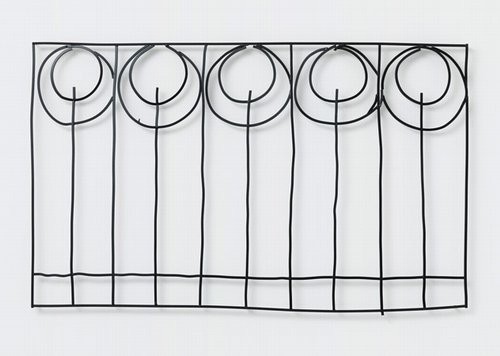Valentin Carron
06 Jun - 31 Jul 2009

© Valentin Carron
Abondance, 2009
Stainless steel, patina effect varnish,
gold-plated iron spacer
91 x 146 x 3.8 cm
Abondance, 2009
Stainless steel, patina effect varnish,
gold-plated iron spacer
91 x 146 x 3.8 cm
VALENTIN CARRON
June 6 2009 - July 31 2009
Galerie Eva Presenhuber is pleased to present a new exhibition by the Swiss artist Valentin Carron.
‚For his second solo show at Galerie Eva Presenhuber, Valentin Carron (1977, Fully) takes as his model the kind of museum display found in European historical institutions. This is a ‘period room,’ where objects belonging to different art historical categories, such as ‘fine’ or ‘decorative arts’ are placed alongside each other, recreating for the viewer a general feel of the aesthetic of a given epoch.
Of course such a canonical display of good taste is always already a show of power, whether that of an old-world bourgeois order (one thinks of the countless public historical museums scattered throughout Europe,) or, in it’s new world embodiment, of raw, private capital (such as the Frick collection in New York).
The works exhibited here either duplicate or inspire themselves from existing artifacts, decorative patterns and public sculptures found in the artist’s immediate surrounding in the Valais. It is a peri-urban region, home to a rural aesthetic supposed to represent, since the late 19th century, the ‘essential’ values of the country, and which exists side by side with a generic version of modernism devoid of progressive ideology.
The result yields a grim, unflinching scale model of a (pan-European) culture incapable of truly renewing itself. Contrary to the beliefs of many artists of Carron’s generation working with nostalgic, avant-garde motifs, this culture – our own – lies just around the corner.’
Text by Fabrice Stroun
June 6 2009 - July 31 2009
Galerie Eva Presenhuber is pleased to present a new exhibition by the Swiss artist Valentin Carron.
‚For his second solo show at Galerie Eva Presenhuber, Valentin Carron (1977, Fully) takes as his model the kind of museum display found in European historical institutions. This is a ‘period room,’ where objects belonging to different art historical categories, such as ‘fine’ or ‘decorative arts’ are placed alongside each other, recreating for the viewer a general feel of the aesthetic of a given epoch.
Of course such a canonical display of good taste is always already a show of power, whether that of an old-world bourgeois order (one thinks of the countless public historical museums scattered throughout Europe,) or, in it’s new world embodiment, of raw, private capital (such as the Frick collection in New York).
The works exhibited here either duplicate or inspire themselves from existing artifacts, decorative patterns and public sculptures found in the artist’s immediate surrounding in the Valais. It is a peri-urban region, home to a rural aesthetic supposed to represent, since the late 19th century, the ‘essential’ values of the country, and which exists side by side with a generic version of modernism devoid of progressive ideology.
The result yields a grim, unflinching scale model of a (pan-European) culture incapable of truly renewing itself. Contrary to the beliefs of many artists of Carron’s generation working with nostalgic, avant-garde motifs, this culture – our own – lies just around the corner.’
Text by Fabrice Stroun
